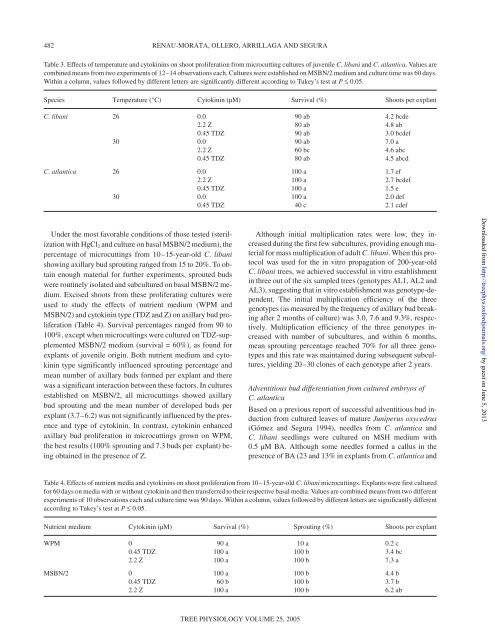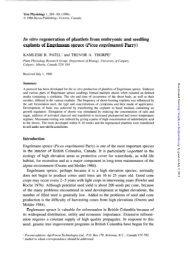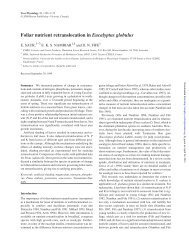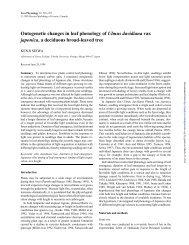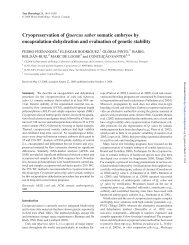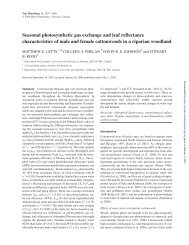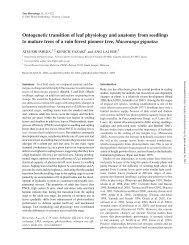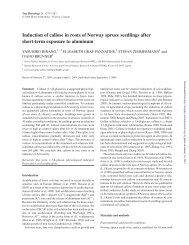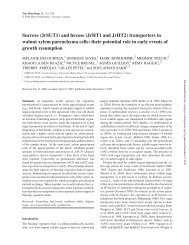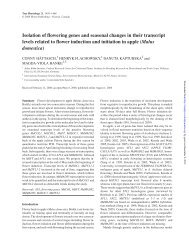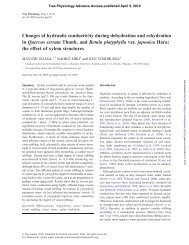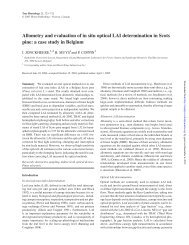Factors influencing axillary shoot proliferation and ... - Tree Physiology
Factors influencing axillary shoot proliferation and ... - Tree Physiology
Factors influencing axillary shoot proliferation and ... - Tree Physiology
Create successful ePaper yourself
Turn your PDF publications into a flip-book with our unique Google optimized e-Paper software.
482 RENAU-MORATA, OLLERO, ARRILLAGA AND SEGURA<br />
Table 3. Effects of temperature <strong>and</strong> cytokinins on <strong>shoot</strong> <strong>proliferation</strong> from microcutting cultures of juvenile C. libani <strong>and</strong> C. atlantica. Values are<br />
combined means from two experiments of 12–14 observations each. Cultures were established on MSBN/2 medium <strong>and</strong> culture time was 60 days.<br />
Within a column, values followed by different letters are significantly different according to Tukey’s test at P ≤ 0.05.<br />
Species Temperature (°C) Cytokinin (µM) Survival (%) Shoots per explant<br />
C. libani 26 0.0 90 ab 4.2 bcde<br />
2.2 Z 80 ab 4.8 ab<br />
0.45 TDZ 90 ab 3.0 bcdef<br />
30 0.0 90 ab 7.0 a<br />
2.2 Z 60 bc 4.6 abc<br />
0.45 TDZ 80 ab 4.5 abcd<br />
C. atlantica 26 0.0 100 a 1.7 ef<br />
2.2 Z 100 a 2.7 bcdef<br />
0.45 TDZ 100 a 1.5 e<br />
30 0.0 100 a 2.0 def<br />
0.45 TDZ 40 c 2.1 cdef<br />
Under the most favorable conditions of those tested (sterilization<br />
with HgCl2 <strong>and</strong> culture on basal MSBN/2 medium), the<br />
percentage of microcuttings from 10–15-year-old C. libani<br />
showing <strong>axillary</strong> bud sprouting ranged from 15 to 20%. To obtain<br />
enough material for further experiments, sprouted buds<br />
were routinely isolated <strong>and</strong> subcultured on basal MSBN/2 medium.<br />
Excised <strong>shoot</strong>s from these proliferating cultures were<br />
used to study the effects of nutrient medium (WPM <strong>and</strong><br />
MSBN/2) <strong>and</strong> cytokinin type (TDZ <strong>and</strong> Z) on <strong>axillary</strong> bud <strong>proliferation</strong><br />
(Table 4). Survival percentages ranged from 90 to<br />
100%, except when microcuttings were cultured on TDZ-supplemented<br />
MSBN/2 medium (survival = 60%), as found for<br />
explants of juvenile origin. Both nutrient medium <strong>and</strong> cytokinin<br />
type significantly influenced sprouting percentage <strong>and</strong><br />
mean number of <strong>axillary</strong> buds formed per explant <strong>and</strong> there<br />
was a significant interaction between these factors. In cultures<br />
established on MSBN/2, all microcuttings showed <strong>axillary</strong><br />
bud sprouting <strong>and</strong> the mean number of developed buds per<br />
explant (3.7–6.2) was not significantly influenced by the presence<br />
<strong>and</strong> type of cytokinin. In contrast, cytokinin enhanced<br />
<strong>axillary</strong> bud <strong>proliferation</strong> in microcuttings grown on WPM,<br />
the best results (100% sprouting <strong>and</strong> 7.3 buds per explant) being<br />
obtained in the presence of Z.<br />
TREE PHYSIOLOGY VOLUME 25, 2005<br />
Although initial multiplication rates were low, they increased<br />
during the first few subcultures, providing enough material<br />
for mass multiplication of adult C. libani. When this protocol<br />
was used for the in vitro propagation of 200-year-old<br />
C. libani trees, we achieved successful in vitro establishment<br />
in three out of the six sampled trees (genotypes AL1, AL2 <strong>and</strong><br />
AL3), suggesting that in vitro establishment was genotype-dependent.<br />
The initial multiplication efficiency of the three<br />
genotypes (as measured by the frequency of <strong>axillary</strong> bud breaking<br />
after 2 months of culture) was 3.0, 7.6 <strong>and</strong> 9.3%, respectively.<br />
Multiplication efficiency of the three genotypes increased<br />
with number of subcultures, <strong>and</strong> within 6 months,<br />
mean sprouting percentage reached 70% for all three genotypes<br />
<strong>and</strong> this rate was maintained during subsequent subcultures,<br />
yielding 20–30 clones of each genotype after 2 years.<br />
Adventitious bud differentiation from cultured embryos of<br />
C. atlantica<br />
Based on a previous report of successful adventitious bud induction<br />
from cultured leaves of mature Juniperus oxycedrus<br />
(Gómez <strong>and</strong> Segura 1994), needles from C. atlantica <strong>and</strong><br />
C. libani seedlings were cultured on MSH medium with<br />
0.5 µM BA. Although some needles formed a callus in the<br />
presence of BA (23 <strong>and</strong> 13% in explants from C. atlantica <strong>and</strong><br />
Table 4. Effects of nutrient media <strong>and</strong> cytokinins on <strong>shoot</strong> <strong>proliferation</strong> from 10–15-year-old C. libani microcuttings. Explants were first cultured<br />
for 60 days on media with or without cytokinin <strong>and</strong> then transferred to their respective basal media. Values are combined means from two different<br />
experiments of 10 observations each <strong>and</strong> culture time was 90 days. Within a column, values followed by different letters are significantly different<br />
according to Tukey’s test at P ≤ 0.05.<br />
Nutrient medium Cytokinin (µM) Survival (%) Sprouting (%) Shoots per explant<br />
WPM 0 90 a 10 a 0.2 c<br />
0.45 TDZ 100 a 100 b 3.4 bc<br />
2.2 Z 100 a 100 b 7.3 a<br />
MSBN/2 0 100 a 100 b 4.4 b<br />
0.45 TDZ 60 b 100 b 3.7 b<br />
2.2 Z 100 a 100 b 6.2 ab<br />
Downloaded from<br />
http://treephys.oxfordjournals.org/ by guest on June 5, 2013


